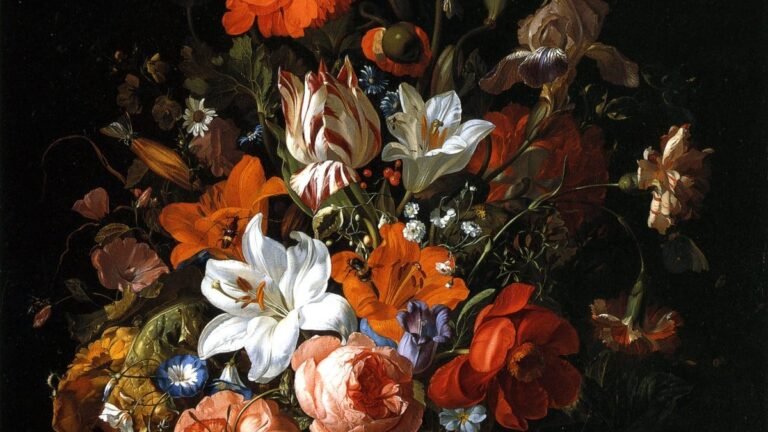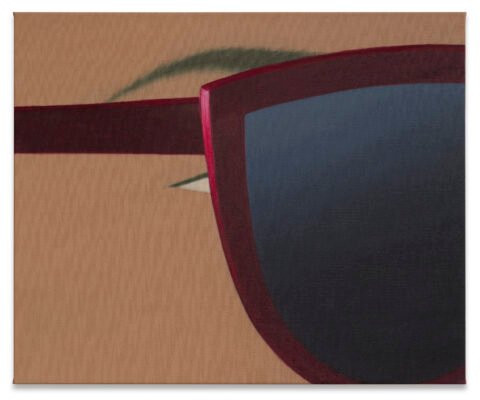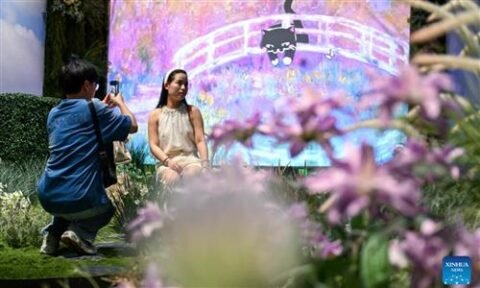TOLEDO – The Dutch painter Rachel Ruysch won the lottery twice — in 1713 and 1723. Most people will be happy for you if you win the lottery once – even if you’re already quite well off, as Ruysch was. A lucky break is always nice. But twice? Twice is gratuitous, surplus to requirements — verging on unnatural.
The second win, in 1723, made Ruysch (1664-1750) and her husband, the portrait painter Juriaen Pool, rich enough that she no longer needed to paint. And so for about 15 years she barely did.
“Rachel Ruysch: Nature Into Art” at the Toledo Museum of Art is the first major monographic exhibition ever devoted to Ruysch, one of the great flower painters of her epoch. Conceived by Robert Schindler and co-curated by Schindler, Bernd Ebert and Anna C. Knaap, the exhibition was organized in tandem with the Alte Pinakothek in Munich and the Museum of Fine Arts, Boston, where it will open in August.
In her 70s, after her post-lottery hiatus, Ruysch took up her brushes again. When she died, at 86, she was feted in a compendium of published poems:
“You do not bemoan your nearly eighty years of life,” wrote the poet and playwright Lucretia Wilhelmina van Merken. “Your winter seems your spring.”
That theme — art as tantamount to a magic trick with the power to reverse time or rival nature – had already been taken up in a poem about Ruysch written more than a decade earlier by Christina Leonora de Neufville: “These cannot be of her creation,” de Neufville wrote of the fruits and flowers in Ruysch’s still lifes. “Would it not be entertaining if I snatched one of these grapes/ from its stem and tasted her painting?”
De Neufville was alluding to the ancient Greek painter Zeuxis, who painted grapes so realistically that birds flew down to try to eat them. Such superfluity was vexing, to birds and poet alike. “Do you not know how cruel it is/ To let our vision feast upon/ That which our tongue must sorely miss?” wrote de Neufville. “I grudge the bee, that you have made with such great skill,/ The fruit you offered him, that he can eat his fill.”
In some ways, Ruysch, though too long neglected by posterity, was like the lucky bees she painted. There is a sense in which her ambition and talent were deliberately excessive, “greater” than nature, and that the “nature” she painted was itself gratuitous in its abundance.
The Toledo show, designed by Selldorf Architects, groans with beautiful bouquets and nosegays. Ruysch’s paintings feature scores of flower species, both native and non-native, as well as insects, lizards, snails, pillowy green leaves and glistening fruit.
But the show is more than an anthophile’s delight. It’s an invitation to get inside the worldview of the artist and her educated, inquisitive circle and to reflect on questions that feel just as relevant today: Can the life of mortal things be artificially prolonged? What is natural, what artificial? What separates art from science? And what role do dominance and exploitation play in the advancement of both?
Ruysch was the granddaughter of Pieter Post, one of the most accomplished architects in the Netherlands, and the daughter of Frederik Ruysch, a renowned professor of anatomy and botany. Famous for his collection of zoological and botanical specimens, Frederik pioneered an embalming technique that made it possible to preserve and present anatomical parts (including human body parts) in astoundingly realistic ways.
Exploration, trade and colonialism were meanwhile rapidly pushing back the horizons of knowledge. Dutch ships brought home specimens of plants and animals never previously seen, even as their owners profited from the slave trade and the exploitation of foreign lands. Frederik Ruysch collected and preserved many of these specimens. At a time when science and art were much more integrated than they appear today, he drew them himself and commissioned others to draw them.
Scientific and artistic minds at the time were especially drawn to the question of reproduction. Some believed in the existence of “spontaneous generation,” an extension of an ancient Greek belief that moisture, heat and decomposing matter (as seen on the floors of forests, for example) could “spontaneously” generate forms of life such as reptiles, amphibians and insects.
Rachel Ruysch’s early paintings, influenced by the “forest floor” paintings of Otto Marseus van Schriek, reveal her exposure to this idea, as do her extraordinary painting and related drawing of a Surinam toad. This South American species, which hatches tiny toads from small sacs on its back, was long thought not to require fertilization by a male.
The idea of spontaneous generation didn’t begin to die until a contemporary of Rachel’s, Maria Sibylla Merian, traveled to Brazil and observed and recorded the life cycle of butterflies, from egg to caterpillar to chrysalis. Merian’s breathtakingly beautiful illustrations also snuffed out the related, pseudo-religious notion that the emergence of butterflies after the “death” of caterpillars was a natural instance of resurrection.
Ruysch had a younger sister, Anna, who has been largely forgotten. (Part of this show’s purpose is to repair the omission.) In the late 1670s, Frederik apprenticed Rachel and possibly Anna to Willem van Aelst, one of the leading flower painters of his day. An engrossing — if nerdy — section of the show delves into the question of which early Ruysch works may be by Anna, or collaborations with Anna, or collaborations with other painters.
Anna’s own painting dwindled after she married in 1688. Five years later, Rachel also married. By now, she had already carved out a healthy market for her ravishingly colored, suavely composed and deliriously detailed flower paintings.
Even as she thrived in her career, she gave birth to 10 children (the first nine in 11 years). Of the 10, only three boys reached adulthood. The labor that went into Ruysch’s paintings was intensive, and her rate of production was very slow.
In 1701, she became the first woman to join the artist’s guild in The Hague. (She and Pool were admitted together.) Seven years later, they were jointly appointed as court painters to the German duke Johann Wilhelm, a prince-elector of the Holy Roman Empire. During the eight years Ruysch spent in Johann Wilhelm’s service, her productivity and painterly ambition both increased.
A portrait by Pool commemorating the end of their joint service feels like another example of gratuitous abundance. It depicts Pool, Ruysch and their son Jan Willem — but it gets more complicated than that. Pool is gesturing toward an easel in the shadows behind him with one of Ruysch’s paintings on it. In the foreground, on the table on which Ruysch rests her arm, is a vase of flowers that Ruysch herself painted in. These flowers are arranged in the same composition as those in the painting on the easel, which, in turn, is nearly identical to a painting that Ruysch had painted the previous year. The picture is a hall of mirrors.
The toads, tropical fruits and tricky portraits in this show are all diverting. But what Ruysch was really all about was flowers — their colors and patterns, their textures, the way they occupy space, pushing forward and receding in relation to one another and to the cushioning green foliage and the dark recessive space out of which they spontaneously spill.
They look so natural! But Ruysch’s arrangements were, of course, highly artificial, improbably combining flowers from all over the world, grafting together elements from different compositions, and generally weaving together the most meticulous observation with the most fantastic invention.
Ruysch and her fellow Dutch flower painters could push things quite far as they unfurled their Turin Shroud-like game of illusion and reality. In some paintings, instead of painting butterflies, they pressed actual butterfly wings into the wet paint and left them there. Such tactics make you reflect anew on the relationship between illusion and reality. They made me, too, contemplate the lottery of life, which somehow, despite everything, we all keep winning (until one day we lose).
Art can seem superfluous, a tautology. (“How vain art is,” wrote Pascal, “exciting our admiration by its resemblance to things we do not even admire in the original.”) But the drive behind art – this strange urge to reproduce reality or invent a new, related but better one – is nonetheless impressive. “This is really all we’ve got,” wrote Ian McEwan, closer to our own, lonelier era, “this increase, this matter of life loving itself; everything else we have has to come from this.”
Rachel Ruysch: Nature into Art Through July 27 at the Toledo Museum of Art (toledomuseum.org) and traveling to the Museum of Fine Arts Boston (mfaboston.org) from Aug. 23 through Dec. 7.





